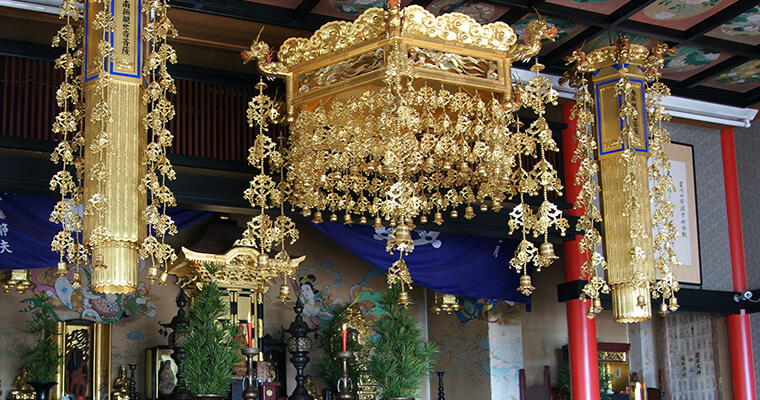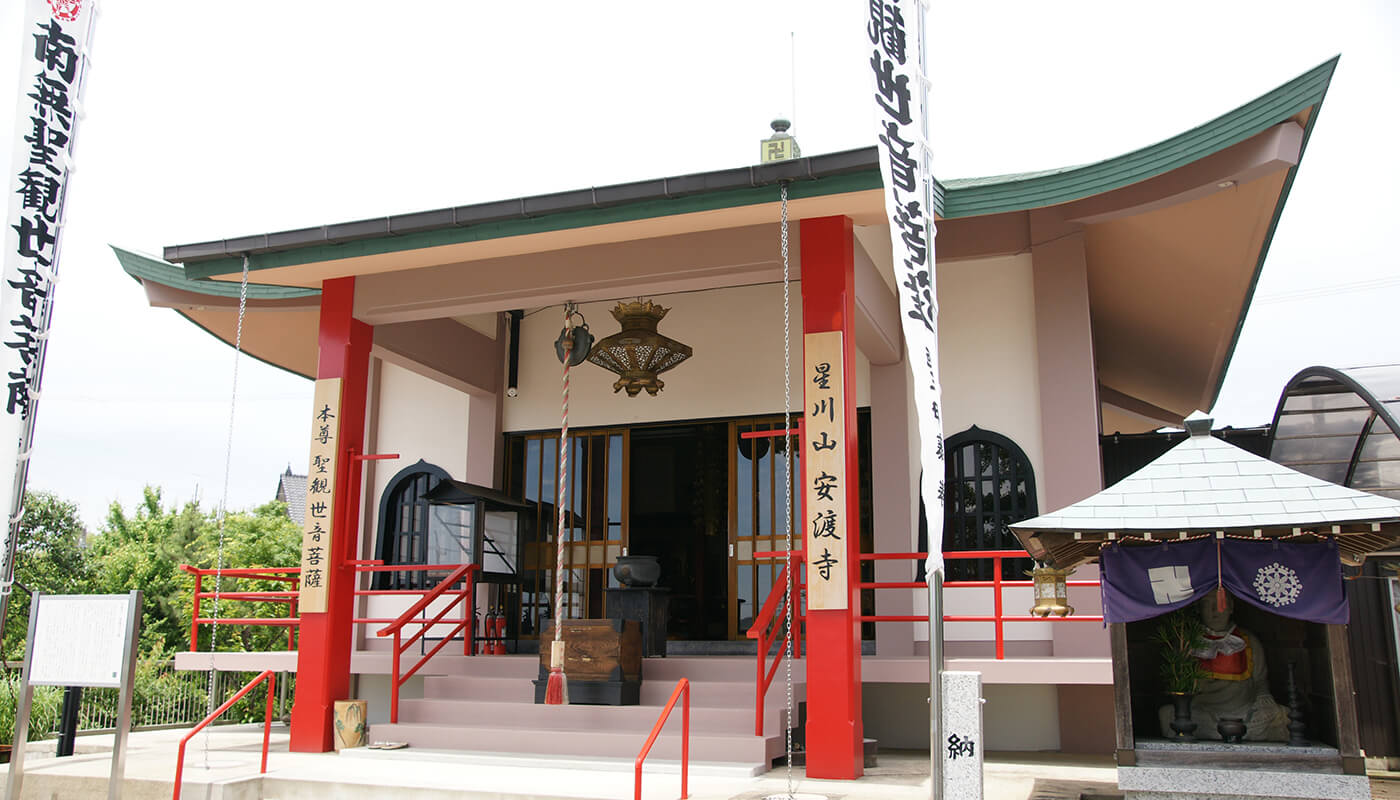Number 30Ando-ji temple
History of the temple
Designated as Cultural Property of Kuwana city
The history of Shō Kannon (Sacred Kannon) worshiped at Ando-ji
The main statue enshrined at Ando-ji temple is a 10th Century 38cm (14.96in) high Shō Kannon (Sacred Kannon) made from a single piece of hinoki cypress. The wooden halo attached to the back of the figure together with the lotus pedestal are 57cm (22.44in) high. It is assumed that originally the statue was painted to some extent but none of the coloring is left on it anymore. Goddess Kannon is holding a lotus flower in its left hand. The right hand is half raised to the chest in symbolic gesture of fearlessness (Abhaya Mudra). The face looks is gentle with a delicate smile. The pattern on the robes of the statue faded away and it is hard to tell what clothes was this Kannon wearing. It was probably decorated in a style typical for Esoteric Buddhism. The simple carving at the back or the deep carving used in the shoulders area or at the bottom of the statue is also typical for Buddhist statues of this size. Together with the restored lotus pedestal and boat-shaped halo it reflects the style of 10th Century Buddhist sculptures. Shō Kannon is not one of the 33 manifestations of Goddess Kannon, but rather represents the root, unchangeable, pure, noble, sacred form of Kannon. The main statue of Ando-ji was made from fragrance wood. Since the 9th Century Tendai temples treated these small statues as second important statues at the altar. Many of these beautiful sculptures were made and some even survived to our times. Without any doubt the Kannon enshrined at Ando-ji is one of them.
Since ancient times Ando-ji was one of sub-temples of Tendai sect and was known as Kannon of Hoshikawa. Historical records mentioning this name were found inside a statue of Buddha Amida. This statue, designated as Yokkaichi city Important Cultural Property, is enshrined in Zenkyō-ji temple of Tomida district. A diary titled Sakuzen Nisshi and written by Fujiwara Saneshige mentions the name at least two times. It states: 2nd year of Jōō period (1223) – offering of 100 sen for the roof of the Hoshikawa temple’s hall; 2nd year of Karoku period (1226) October – offering of 100 sen for a hot water boiling pot, 2800 rolls of Heart Sutra chanted. These two entries tells us that at the beginning of the 13th Century there was a Kannon Hall at the temple, and that water for making food was boiled.
Ando-ji has a goeika (song of praise recited at the end of Buddhist ceremony): The stars reflecting on the water (in Japanese hoshikawa, it is also the name of the mountain), looks like a calm river easy to cross (in Japanese ando, it is the name of the temple).
The temple holds a number 30 of Ise Saikoku Kannon Pilgrimage. Kannon of Ando-ji is especially known as Koyasu Kannon (goddess of childbirth and guardian of children) and many women come to ask her for help. She is also worshiped by local people as a fortune bringer and protector against bad luck. Each year on the 10th of January a prayer called Hatsu Kannon-e (first Kannon prayer of the New Year) is held, during which monk and the believers pray for safety of the households, good fortune and expelling of bad luck. Another popular festival called Tōka Kannon (Kannon of the 10th day) or Tōka Bon (the 10th day Festival of the Dead) is also held every year on the 10th of August.
Appendix
1956 July 15th – The temple was designated as Tangible Cultural Property of Kuwana city
Seiyōzakki
Hoshikawazan Ando-ji, the main statue is Senju Kannon (Thousend-Armed Kannon). The temple is a number 30 of Ise Pilgrimage.
The stars reflecting on the water, looks like a calm river easy to cross.

Outline
-
Honorific name
Hoshikawazan
-
Temple's name
Ando-ji
-
Sect
Independent
-
Religious service
Shō Kannon
(Sacred Kannon)





